|
|
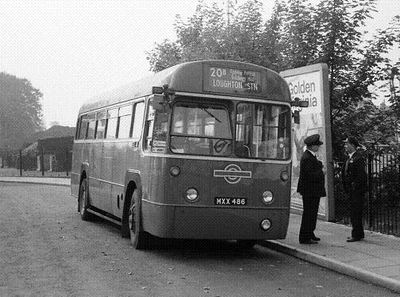 Red RF routes Red RF routes
Route 20B
Page last updated 12 November
2020
Introduction of the 20 B marked the first
weekday replacement of a section of a double-deck route
by single-deck OMO in London (the 203 had
already converted on Sundays). The northern part of
RT-operated 20 was replaced (except on Saturdays) by the OMO
RF-operated 20 B in October 1965. This was the
first occasion on which the allocation of single-deck routes in the
200-series ( introduced in
1934) had been abandoned.
On that first day, 3 Oct
65, RF509 has been newly transferred from Kingston for the new
route. Some discussion takes place on a deserted Loughton
Station forecourt.
Photo © Rob Sheen
Dates of RF operation
3 Oct 65 to 13 Jun 69
(total 3 years 8 months, all
OMO)
Destinations
LOUGHTON STATION and EPPING
TOWN (Mon-Fri, Sun, also RT-operated on Sats from 31 Dec
66)
LOUGHTON STATION and EPPING St Margaret’s
Hospital (Mon-Fri afternoons and evenings, Sun
afternoons)
BUCKHURST HILL STATION and EPPING
TOWN (Mon-Fri peaks)
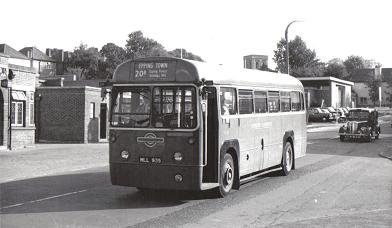 RF Garages RF Garages
L Loughton
Evening light follows RF517
to Epping Town.
Photo: Peter Gomm
collection
Reason for single-deck operation
At the time of conversion, only RFs were available for OMO
operation.
Route history
The Epping to Loughton route has a long history.
According to the Essex Countryside magazine (January 1967) 'three
famous old Epping horses with just one eye between them proudly
drew the coach driven by Joe Wilks of Tidy's Lane from the Cock
Hotel to meet the trains at Loughton station when the railway first
reached there in 1867'. The General covered the road
periodically from 1915, when the 10B between Epping and
Elephant & Castle started operation on Sundays in
July. In October 1921, the route became daily as
10A - renumbered (under the Bassom system) 100 and
100A between 1924 and 1934 - all a
variation of the famous 10 to Abridge. In November
1939, the route was shortened to run between Epping and
Leytonstone. It was double-deck operated throughout, with K,
S, NS, ST, LT and finally STD-types. On 30 Jun 48,
the 10A was renumbered 20, and in March 1955, Loughton's
STDs were replaced with RTs.
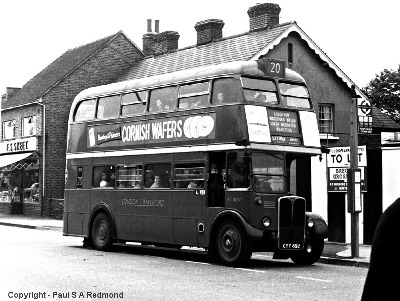 The
20 offered journeys extended to Epping St Margaret's
Hospital on Sundays from 1954 and daily from 1963. Here,
Loughton's Saunders-bodied RT1837 arrives in Epping. Photo © Paul Redmond
When one-man operation was finally introduced in the
Central Area in 1964, following the Phelps Brown report, it was
permitted only on single-deck buses. Whereas ten years
before, it had been London Transport policy to double-deck all
Central Area routes where physically possible, it became inevitable
that the reverse would happen on lightly-used routes. The 20
was the first.
The busy Saturday service (Epping and Leytonstone) was left
untouched initially, but other days of the week were replaced on 3
October 1965 by new OMO route 20 B over the Loughton
to Epping section of the 20, with the southern part covered by the
RT-operated 20 A (Leytonstone to Debden). The
creation of the 20 B broke the rule of over 40 years that
all single-deck routes were numbered in
the 200-series, and occured simultaneously with the
OMO-conversion of Loughton's existing RF route, the 254, and the creation the next day of the
291 out of part of Barking's
RT-operated 129.
The remaining Saturday operation on the 20 ended on 24
Dec 66, being shortened and renumbered 20B on the
following Saturday, still with RTs. This led to the situation
where the 20A and 20B were variants of a
route that no longer existed, and the OMO
20B was crew operated on Saturdays.
A new RT route 20 from Loughton was introduced on 7
Sep 68 as part of the huge revisions resulting from the opening of
the first stage of the Victoria Line and the Bus Reshaping Plan. It took a different
routing south of Woodford to Leyton and Walthamstow from the old
20, and replaced much of the 38A. Six
months later this was converted to OMO MB operation and extended to
Epping to absorb the 20 B. Meanwhile the
20 A continued with RTs until 1976, when it swapped the
Loughton to Epping section with the 20 and became DMS operated over
the original 20 route, lasting until 1982. Falling entirely
outside Greater London, the 20 B roads are no longer
served by TfL.
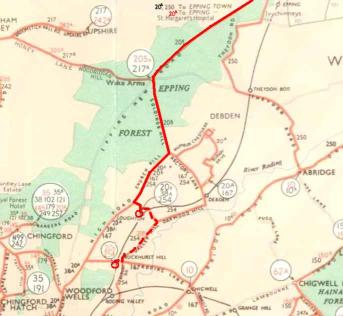 RF route in
detail, RF route in
detail, with timing points
EPPING St Margaret’s Hospital (mid-afternoons Mon-Fri
& Sun, evenings Mon-Fri, also RT Sat mid-afternoons from 31 Dec
66), The Plain (Ongar Road), Palmers Hill, EPPING TOWN Grove
Lane (northbound described as EPPING TOWN
Cock) (RF Mon-Fri and Suns, also RT Sats from 31 Dec
66), Epping High Street, Epping (New) Rd, Epping Forest Wake Arms, Goldings
Hill, Church Hill, Loughton
Garage, High Road Loughton, Old Station Road, LOUGHTON
STATION, extended Mon-Fri peaks Alderton Hill, Roding Road, Valley
Hill, Loughton Way, BUCKHURST HILL STATION
Terminal working at Epping Town: clockwise from High Street to
Hemnall Street, Grove Lane to stand, exit to High Street.
Frequency between Epping Town and
Loughton
| Year |
Mon-Fri |
Sat |
Sun |
| 1966 |
20-30 mins |
n/a |
21-30 mins |
| 1967 |
20-30 mins |
30 mins [RT] |
60 mins |
| 1969 |
20-30 mins |
30 mins [RT] |
60 mins |
From Epping Town, the route took about 24 minutes to Loughton
Station and a further 9 minutes to Buckhurst Hill. The July
1967 timetable is here.
1968 bus map © London
Transport. 20A and 20B but no 20.
RF allocation
PVR Oct 1965: Mon-Fri 4+, Sat -, Sun 4
PVR Dec 1966: Mon-Fri 4, Sat [3 RT], Sun 3
PVR Feb 1969: Mon-Fri 4+, Sat [3 RT], Sun 2
+ plus 1RF ex 254
Re-creation
RFs worked the 20B at the 2007 Loughton Running Day.
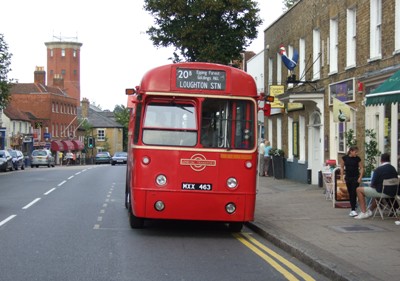
RF486 outside the former
Cock Hotel, Epping, recreating the 20B through Epping
Forest. The tower is one of three in Epping and is part of
the District Council offices.
Photo © Peter Osborn
|
|